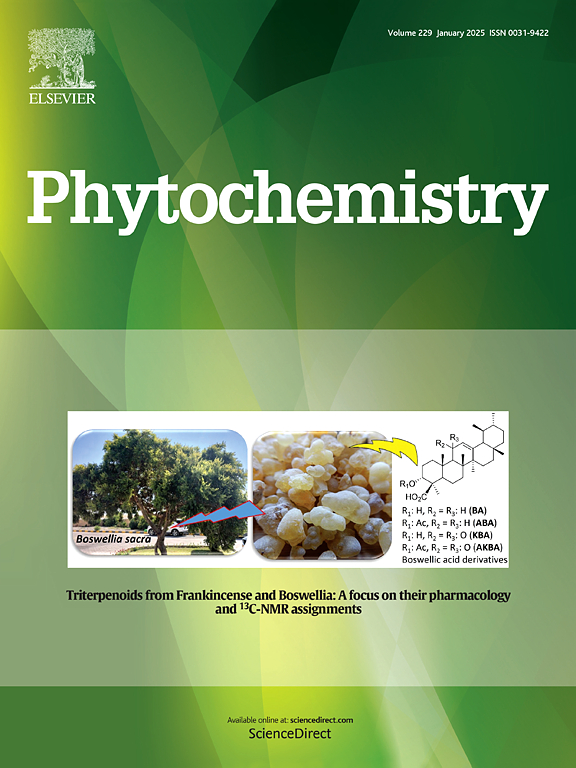外源性一氧化氮可减轻1,3-二丁基咪唑溴对谷子的毒性
IF 3.4
2区 生物学
Q2 BIOCHEMISTRY & MOLECULAR BIOLOGY
引用次数: 0
摘要
离子液体表现出独特的特性,包括低蒸气压、高热稳定性、良好的导电性和多种设计可能性,这使得它们适用于各个领域。然而,它们日益增加的利用引起了人们对生态毒性的关注。本研究考察了1,3-二丁基咪唑溴(DIB)对谷子的影响,并考察了外源性一氧化氮供体硝普钠对DIB毒性的影响。生理分析表明,DIB处理抑制了种子萌发和幼苗生长,降低了叶绿素含量;相反,谷子的丙二醛水平显著升高。外源性一氧化氮减轻了这些有害影响。一氧化氮还能提高谷子叶片过氧化物酶活性,增加脯氨酸和可溶性糖两种渗透调节化合物的浓度。RNA测序结果表明,一氧化氮可能通过调节叶绿素代谢、各种次生代谢物的生物合成途径、涉及乙烯和茉莉酸反应的信号转导以及与金属离子结合相关的过程来减轻dib诱导的植物毒性。这些研究不仅阐明了离子液体对植物生理的具体影响,而且为利用外源一氧化氮作为农业实践中减轻毒性的有效策略提供了科学依据。本文章由计算机程序翻译,如有差异,请以英文原文为准。

Exogenous nitric oxide alleviates the toxicity of 1,3-dibutyl imidazole bromide on foxtail millet
Ionic liquids exhibit distinctive properties, including low vapor pressure, high thermal stability, good electrical conductivity, and versatile design possibilities, which render them applicable across various fields. However, their increasing utilization has raised concerns regarding ecotoxicity. This study investigates the impact of 1,3-dibutyl imidazole bromide (DIB) on foxtail millet and examines the effects of exogenously applied sodium nitroprusside, a nitric oxide donor, on the toxicity of DIB. Physiological analyses indicated that DIB treatment inhibits seed germination and seedling growth, and decreases chlorophyll content; conversely, malondialdehyde levels were notably elevated in foxtail millet. The exogenously applied nitric oxide mitigated these detrimental effects. Nitric oxide also enhanced peroxidase activity and increased the concentrations of two osmotic regulation compounds, proline and soluble sugars, in leaves of foxtail millet. RNA sequencing results suggested that nitric oxide alleviates DIB-induced phytotoxicity possibly through modulation of chlorophyll metabolism, biosynthesis pathways for various secondary metabolites, signaling transduction involving ethylene and jasmonate responses, as well as processes related to metal ion binding. These investigations not only elucidate the specific impacts of ionic liquids on plant physiology but also provide a scientific basis for employing exogenous nitric oxide as an effective strategy for mitigating toxicity in agricultural practices.
求助全文
通过发布文献求助,成功后即可免费获取论文全文。
去求助
来源期刊

Phytochemistry
生物-植物科学
CiteScore
6.40
自引率
7.90%
发文量
443
审稿时长
39 days
期刊介绍:
Phytochemistry is a leading international journal publishing studies of plant chemistry, biochemistry, molecular biology and genetics, structure and bioactivities of phytochemicals, including ''-omics'' and bioinformatics/computational biology approaches. Phytochemistry is a primary source for papers dealing with phytochemicals, especially reports concerning their biosynthesis, regulation, and biological properties both in planta and as bioactive principles. Articles are published online as soon as possible as Articles-in-Press and in 12 volumes per year. Occasional topic-focussed special issues are published composed of papers from invited authors.
 求助内容:
求助内容: 应助结果提醒方式:
应助结果提醒方式:


